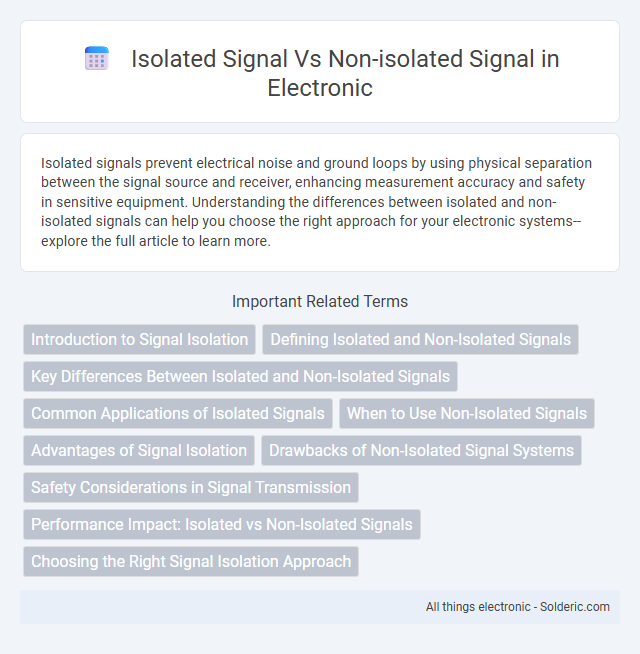Isolated signals prevent electrical noise and ground loops by using physical separation between the signal source and receiver, enhancing measurement accuracy and safety in sensitive equipment. Understanding the differences between isolated and non-isolated signals can help you choose the right approach for your electronic systems--explore the full article to learn more.
Comparison Table
| Feature | Isolated Signal | Non-Isolated Signal |
|---|---|---|
| Definition | Signal electrically separated from ground reference | Signal shares common ground reference |
| Electrical Isolation | Yes, prevents ground loops and interference | No, potential for ground loops and noise |
| Noise Immunity | High resistance to electromagnetic interference (EMI) | Lower resistance to EMI and noise |
| Safety | Enhanced safety by isolating high voltages | Lower safety margin in high voltage applications |
| Signal Integrity | Better preservation of signal quality | More susceptible to signal degradation |
| Cost | Higher due to isolation components | Lower due to simpler design |
| Application Examples | Medical devices, industrial automation, data acquisition | Consumer electronics, basic sensor connections |
Introduction to Signal Isolation
Signal isolation separates electrical signals to prevent interference and ensure accurate data transmission in electronic systems. Isolated signals use transformers, optocouplers, or capacitive couplers to maintain galvanic separation, enhancing safety and reducing noise. Understanding the difference between isolated and non-isolated signals helps optimize your system's performance and reliability in various industrial and communication applications.
Defining Isolated and Non-Isolated Signals
Isolated signals are electrical signals transmitted through barriers that prevent direct electrical connection, ensuring no shared current paths and providing protection from noise and ground loops. Non-isolated signals, by contrast, share a common ground or reference point, enabling direct electrical coupling but increasing susceptibility to interference and potential ground loop issues. Understanding these differences helps you select the appropriate signal type for applications requiring noise immunity and safety versus simpler, cost-effective data transmission.
Key Differences Between Isolated and Non-Isolated Signals
Isolated signals use galvanic isolation to prevent direct electrical connection between circuits, enhancing safety and reducing noise interference, while non-isolated signals share a common ground, allowing easier integration but increasing the risk of ground loops and interference. Isolated signals are essential in medical and industrial applications requiring high precision and protection, whereas non-isolated signals are more suitable for cost-sensitive or low-voltage environments. Your choice between these depends on the need for electrical isolation, noise immunity, and system complexity.
Common Applications of Isolated Signals
Isolated signals are commonly used in industrial automation, medical devices, and power supply systems to prevent ground loops and enhance safety by electrically separating input and output. They provide noise immunity in environments with high electromagnetic interference, ensuring accurate data transmission in sensor interfacing and communication protocols like RS-485. Battery-operated equipment and data acquisition systems often incorporate isolated signals to minimize current leakage and protect sensitive components.
When to Use Non-Isolated Signals
Non-isolated signals are ideal when you need direct electrical connections that allow for simpler, lower-cost, and faster communication between components, especially in environments with minimal noise or interference. You should use non-isolated signals when devices share a common ground and isolation barriers are unnecessary, such as within the same circuit board or closely integrated systems. Your choice of non-isolated signals enhances system efficiency when electrical isolation is not a critical safety or noise reduction factor.
Advantages of Signal Isolation
Signal isolation enhances noise immunity by preventing ground loops and electromagnetic interference, ensuring cleaner signal transmission in industrial automation and instrumentation. It protects sensitive electronics from high voltage spikes and transient surges, extending equipment lifespan and reliability. Isolated signals improve measurement accuracy by eliminating common-mode noise, crucial in precision applications like medical devices and aerospace systems.
Drawbacks of Non-Isolated Signal Systems
Non-isolated signal systems often suffer from ground loop issues, leading to increased noise and signal distortion that degrade measurement accuracy. These systems lack electrical separation, making them vulnerable to common-mode voltage interference and potential damage from voltage spikes. Your equipment's reliability and data integrity can be compromised without isolation in noisy or high-voltage environments.
Safety Considerations in Signal Transmission
Isolated signals provide enhanced safety by preventing electrical noise, voltage spikes, and ground loops from damaging equipment or causing hazardous conditions, ensuring reliable signal transmission in sensitive environments. Non-isolated signals, lacking this separation, may pose risks of electrical shock, equipment interference, and potential system failures due to direct electrical connections. Your choice of isolated signals is crucial for maintaining operational safety and protecting both personnel and devices in complex industrial or medical applications.
Performance Impact: Isolated vs Non-Isolated Signals
Isolated signals provide superior noise immunity and prevent ground loops, resulting in more accurate and reliable data transmission compared to non-isolated signals. Non-isolated signals are susceptible to interference from common-mode voltages, which can degrade signal integrity and cause measurement errors in sensitive applications. Therefore, isolated signal interfaces enhance system performance in industrial automation, medical devices, and instrumentation by ensuring signal clarity and protecting against electrical hazards.
Choosing the Right Signal Isolation Approach
Choosing the right signal isolation approach depends on the application's voltage levels, noise immunity requirements, and safety standards. Isolated signals provide galvanic isolation to prevent ground loops and protect sensitive equipment, making them ideal for industrial automation and medical devices. Non-isolated signals are suitable for low-noise environments where cost and simplicity are priorities, but they lack protection against high voltage transients and potential interference.
Isolated signal vs non-isolated signal Infographic

 solderic.com
solderic.com